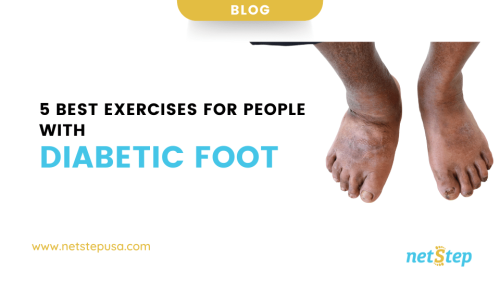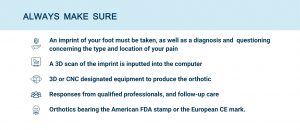
5 Best Exercises for People with Diabetic Foot
Exercise is associated with many health advantages for diabetic foot. Not only can it reduce the amount of stress you feel, but it also can
Get $100 for your second pair
Whether you’re athletes, just love walking, or prefer to be a couch potato, choosing comfortable shoes which are correct for your feet and lifestyle is the basis for taking good care of your feet in the short, and long, term. Choosing orthotics to insert into your shoes is no less important, and perhaps more so, because orthotics can make every pair of shoes comfy and of orthopedic quality. Customized orthotics are now in everyone’s reach. And no, they’re no longer meant only for people suffering with foot problems or illnesses. Here’s the full guide on buying orthotics. Why is it important to make the right choice? How can you be sure you’ve got quality orthotics? And what types are available?
What are orthotics?
Orthotics, also known as orthoses, are an accessory inserted into the shoe. Their purpose is to provide support for the sole of your foot. The first orthotics were produced by innkeepers who sought to address the needs of exhausted travelers complaining of tired, and often painful, feet. Over time, professional shoemakers produced leather orthotics but they eventually became known for their lack of flexibility and comfort. The evolution, or more precisely, the revolution, in orthotics eventually came about due to current technologies able to integrate plastic polymers. These are artificial materials heated and molded to precisely fit a person’s sole. 21st century technologies have led to advances in the field that fully personalize orthotics of higher quality and comfort than ever.
Current production of customized orthotics leverages 3D scanning which allows for extremely high level precision, a larger number of foot support options, and other elements not available in the past, such as corrective heel angle, additional support to correct walking, personalization for each foot’s needs, and more. Orthotics now use 3D printing or CNC technology, both of which enable strength and comfort along with a very thin profile.
Why are orthotics so important?
In the past orthotics were designated for resolving specific foot problems. These days, though, the view is that everyone can be assisted by personalized orthotics, whether they’re for sports, leisure, or therapeutic purposes. Our feet work really hard all day. They get exhausted, they get damaged as we walk, they absorb shocks and other events that can cause pain to the soles, ankles and knees. Quality orthotics absorb shocks, create balanced weight spread, and provide better and correct support for our feet’s arches.
How can you tell if an orthotic is good quality?
A wide range of orthotics is available in the market these days. That means it’s very important to identify their quality and professionalism, which can directly influence your walking, and the quality of care your back receives.
One of the oldest methods prepares orthotics based on a plaster cast over which polymers are melted. These orthotics tend to be thick, clumsy, and require particularly heavy shoes. Using orthotics of this kind makes it really hard to precisely correct the foot’s posture, resulting in a generally poorer level of treatment. A different technology produces orthotics made by lightly heating the material and adjusting them to the individual’s foot. The biggest disadvantage with these is that they don’t improve or correct walking, or the foot’s posture. Wear and tear on this type of orthotic is fast, which means they can’t maintain high level performance over time.
So how CAN you tell if a specific orthotic is high quality? When it comes to the process of measuring the individual’s foot print, so to speak, a diagnosis and thorough questioning should be conducted concerning the type of pain and its location. The diagnosis and client responses allow reaching a conclusion concerning the kind of corrective measures needed. Scanning the foot imprint into the computer, and producing and shaping the orthotic using 3D technology, personalizes the orthotic to each client’s foot. It’s valuable to ensure that you’re buying orthotics produced by 3D printers or CNC technology, which have the highest precision and allow a perfect fit for your feet. It’s no less important that the orthotics’ structure and materials suit the kind of activity you’re involved in, and your foot’s posture. Pay attention to the company producing the orthotics, and note whether it addresses issues through professional input from physicians and physiotherapists. Why is this important? Because you don’t want an incorrect diagnosis, or orthotics that won’t suit your feet. Both these outcomes can actually case more harm than good. The organization producing the orthotics should also offer follow-up care from a technician who can provide ongoing treatment if needed. We also recommend purchasing orthotics bearing the European “CE” marking, the American “FDA” certification, or the Israeli Ministry of Health authorization.

What kinds of orthotics are available? And how do they differ from each other?
Many people buying orthotics make their choice according to the type of material they’re made from rather than their typical activities. Choosing by type of materials is not the right way to go about things, as that doesn’t coordinate with the variety of a person’s activities across the day, and may not match the person’s authentic needs. Orthotics should be chosen based on what you do, and integrated with the pain diagnosis, and any current pathologies.
Three main types of orthotics are available: sports, lifestyle and therapeutic. Each category contains several subcategories.
Fitting orthotics for athletes is based on the type of physical activity they’re involved in and how it affects their feet. Basketball, for example, involves jumping and landing, tennis involves a lot of sudden stops, professional and amateur runners need to address shock absorption, and so on. Sports orthotics differ for tennis, running, hockey, golf, baseball, bicycling, football. There are also unique orthotics for soldiers, hikers and more. All these are customized to the individual’s personal needs.
These orthotics are customized to the individual’s needs across the life span and become an integral part of the individual’s life and activities, whether that involves lengthy periods of standing, wearing high heels or elegant shoes, and so on. Orthotics of this kind address the needs of people who want their orthotics tailor made to fit their shoe and foot like a glove, allowing freedom and comfort.
Lifestyle orthotics include comfort orthotics, soldiers’ orthotics, orthotics for sneakers, orthotics for high heels, orthotics for elegant footwear and for sandals, and customized to the individual.
These address side effects and short or long term phenomena resulting from injuries and / or various illnesses that impact the foot. They are a pinpointed means of addressing diabetes, for example, and pathological foot issues such as spur pain, back pain and hallux rigidus , which is the wear and tear on the large toe’s cartilage. These orthotics also address genetic and hereditary problems. Therapeutic orthotics also include orthotics for foot pain, knee pain, and lower back pain, orthotics for diabetics, orthotics to treat flat foot, orthotics to correct hallux valgus, orthotics for metatarsalgia pain, orthopedic orthotics, and more.
Whether you need orthotics to help treat pain, or don’t experience pain at all, it’s important to know that using orthotics can have a profound effect on the individual’s life, both in children and adults. It can be likened to using sunglasses, an accessory that helps care for our eyes. Just as we slip sunglasses on as soon as we go outdoors, we’d do well to slip orthotics into our shoes as soon as we put our feet into those shoes. Orthotics are a way of setting yourself a safe path and comfortable journey for your entire life.
And now you can get recommended orthotics in one click. Take advantage of the professionalism and quality of experts from the field. For more information, prices and ordering, click here>>

Exercise is associated with many health advantages for diabetic foot. Not only can it reduce the amount of stress you feel, but it also can

Football is a high-speed and high-energy activity hence players frequently suffer football injuries. Whether you play football yourself or have a youngster who is obsessed
